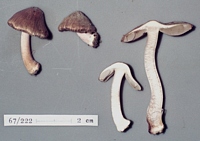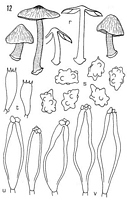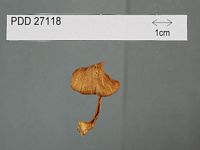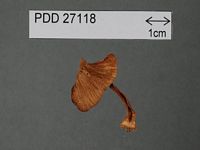|
 Astrosporina avellana Astrosporina avellana
BiostatusPresent in region - Indigenous. Non endemic
Images (click to enlarge)
Caption: 67/222: Astrosporina avelanoides
Owner: Egon Horak | 
Caption: Astrosporina avellana (type):
r, carpophores; s, spores; t, basidia; u ' cheilocystidia; v, pleuro-cystidia. | 
Caption: Dried type specimen
Owner: Herb PDD | 
Caption: Dried type specimen
Owner: Herb PDD | |
Article: Horak, E. (1978) [1977]. Fungi Agaricini Novaezelandiae. VI. Inocybe (Fr.) Fr. and Astrosporina Schroeter. New Zealand Journal of Botany 15(4): 713–747 (http://www.rsnz.org/publish/abstracts.php).
Description: Pileus -50 mm diam., convex with broad umbo,
campanulate, expanded in old carpophores; colour varying from beige, light brown
to hazel-brown, yellow or ochre tints absent; strongly innate fibrillose, rimose
and splitting towards the striate margin, centre smooth; subviscid when wet,
veil remnants absent. Lamellae adnexed to adnate, crowded (1 -7), ventricose;
whitish grey turning grey-beige, with white fimbriate edges. Stipe 35-60 x 4-6
mm, cylindrical, with strongly marginate bulb (-14mm diam.); white later turning
light brown with reddish or pink tints; pruinate all over, often substriate
with longitudinal lines; veil remnants none, dry, solid, single or in groups.
Context white in pileus, reddish brown in cortex of stipe. Odour not distinctive.
Spores 9-11 x 6.5-9 µm, nodulose, knobs conspicuous,
brown. Basidia 25-40 x 10-13 µm, 4-spored. Cheilo- and pleurocystidia 45-90
x 10-24 µm, fusoid, thick-walled (-4 µm diam.), encrusted, hyaline. Caulocystidia
identical. Cuticle a cutis of repent cylindrical hyphae (6-15 µm diam.), encrusted
with yellow-brown pigment. Clamp connections present.
Habitat: On soil in Nothofagus forests (N.
cliffortioides, N. menziesii, N. fusca). New Zealand.
Notes: Macroscopically there are no differences
between A. avellana from New Zealand and Inocybe fuscata Singer
from the Nothofagus forests of Chile and Argentina. Microscopical examination,
however, shows that the morphology of the spores and cystidia is distinct. Inocybe
tequendamae Singer (from Colombia) is another closely related species in
South America associated with Quercus spp.
|